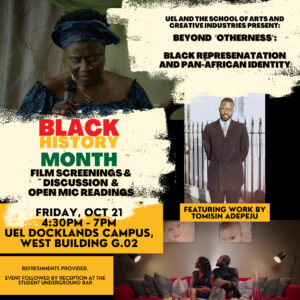“What skin colour would you like your child to be?” asks the advisor seated across from the black couple.
“You could have a white baby, everyone wants to give their child the best possible start in life, don’t they? Just think about what white skin gives you”, adds the advisor.
This was great dialogue in a sci-fi film, one of the short films screened at “Beyond Otherness: Black representation and Pan-African identity” at the University of East London.
We are watching films, and discussing representation, what it is like being the “other” in the room and how hard it can be to fit in.

Before the screening, I had no idea what “othering” meant. Othering is the act of treating someone as though they are not part of a group – they are fundamentally different, “other”. As a person of colour and a Nigerian, it was not until I got to the UK that I realised that having a darker skin colour can make you feel othered. Because in Nigeria this doesn’t matter.
Here’s what I thought of films at the screening.
Play It Safe
Play It Safe examines “fitting in” and racism through the experience of the daily discomfort of a black man in an all-white drama school. Written and directed by Mitch Kalisa it stars Johnathan Ajayi who is himself a writer as well as an actor.
Rather than direct racism, it is the subtle presumptions based on skin colour that features. So for example, Johnathan is pushed into playing the role of street thug in a production because it was thought he was the right fit.
In a striking device to examine fitting in, when a group of actors randomly choose animal cards as an acting exercise Johnathan gets an ape card. Although uncomfortable he proceeds to act like an ape.
Although the film didn’t exactly have personal resonance for me, it did work. It felt uncomfortable to watch as I imagined myself in that situation. I don’t think I would be able to handle everything Johnathan went through. It felt dehumanizing and wrong to be subject to the treatment he faced.
The Right Choice
The Right Choice is set in 2074. Mr and Mrs Dimka, a black couple, have approached a clinic to design the perfect baby, a baby that would be accepted by society. It discusses issues around gender, sexuality, and skin colour.
The Dimkas are constantly told they should do everything possible to choose a child who will have the best opportunities in life.
For example, they are bombarded with arguments against their intial choice to have a girl. There is domestic violence, it’s a man’s world, she could face sexual abuse, the advisor says.
The design process continues with the advisor asking the couple to pick the sexuality of their child. They are astounded that this could be determined. Once again, they are told about the challenges of having a homosexual child.
Finally, the choice of race: “What skin colour would you like?” “You could have a white baby, everyone wants to give their child the best possible start in life, don’t they? Just think about what white skin gives you”, the advisor says.
Written and directed by Tomisin Adepeju and Vijay Varman, the film uses sarcasm and dark humour to tell its story.
It’s a film that reflects how people may feel compelled to fit in. When I was younger I tried so hard to fit in. Growing up with four brothers I always wondered why I was a girl and not a boy like my siblings. I remember praying to God to turn me into a boy several times. But as I grew older fitting in became much less important. Indeed, I now consider being a woman is one of the best things that could ever have happened to me.
Appreciation
The final film was Appreciation. Written and directed by Tomisin Adepeju, it is about a pastor who loses her child and explores how she deals with the grief that results.
The pastor tries to continue her normal daily activities like shopping, ministering in her church and visiting friends, but ultimately she breaks down. She can no longer act like she was okay. Her church congregation proceed to comfort her in their own way.
This was a strong theme for me. Older people around me have always done a really good job hiding their emotions. Growing up, only once did I see someone older express their grief. This was when my grandma cried when she lost her dad. I was astonished at the time.
So is this supression of emotion normal? Should we be more open to emotion?
After the screening, Tomisin explained that this film was personal. It was inspired by the woman who had been the pastor of his church for 25 years.
Tomisin told the audience that he realised that this did not easily fit into the idea of otherness as grief is universal. However, he noted that the loss connected to grief was not just about a person. Loss is “sometimes a loss of identity and culture, a loss of one’s way of life. Loss is an immensely powerful theme”, he said.
Summing it up
In his closing remarks, Tomisin summarised some of his key motivations:
“We need to be properly represented as black people. I encourage us all to embrace our flaws, complexion, and people as a whole. I also urge directors and writers to depict people of colour as people with emotions and ambitions and not just as violent and emotionless.”
Attending this screening made me reflect on a lot of things. It opened my eyes to things I didn’t consider were problems: subtle racism, people trying to fit in and people showing emotions – and perhaps the loss associated with loss of culture.
And then I thought back to my parents. Appreciation made me think about the emotions they undoubtedly have. How are they really doing? Maybe we could talk…



